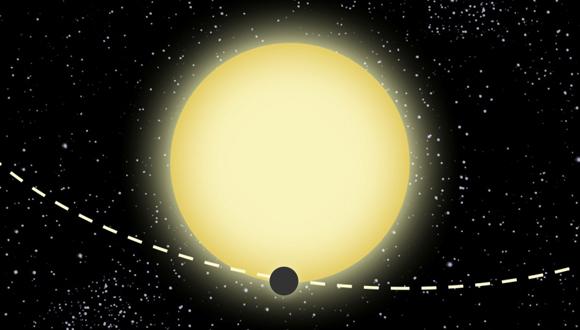TAU team takes part in discovering new planet
A team of astronomers at TAU and the Harvard-Smithsonian Center for Astrophysics have announced the first-ever discovery of an extrasolar planet via induced relativistic beaming of light from the host star.
For the past two years, Professor Tsevi Mazeh and his PhD student, Simchon Faigler, from the School of Physics and Astronomy at TAU, have been searching for planets around other stars using a novel detection method. Their technique is based on identifying three very small effects that occur simultaneously as a planet orbits a star. The first effect is Einstein's relativistic "beaming" effect that causes a star to brighten and dim as it is tugged back and forth by an orbiting planet. Detection of planets via the beaming effect was predicted in 2003 by Prof. Avi Loeb, Harvard University and Sackler Professor by Special Appointment at Tel Aviv University, and Prof. Scott Gaudi (now at Ohio State University).
The second effect that the Faigler-Mazeh method looks for is the stretching of a star into a football shape by the gravitational tides raised by an orbiting planet. Such distorted star appears brighter when observed from the side, due to the larger visible surface area, and fainter when viewed end-on. The third small effect is due to starlight reflected by the planet itself.
Because the brightness variations are extremely small (on the order of one part in ten-thousand), these effects can be detected only with accurate data obtained by space missions. The Tel Aviv team, which is supported by a European Research Council Advanced Grant, analyzed data for more than one hundred thousand stars obtained with the NASA space mission Kepler, looking for the beaming and the two other modulations. After discovering a planet candidate, they collaborate with Dr. David Latham from the CfA and his team, which includes Dr. Lars Buchhave, to observe the candidate from the ground for additional spectroscopic confirmation.
On May 3rd 2012 Faigler and Mazeh noticed the three effects in one of the stars observed by Kepler. Ground-based observations to confirm the planet detection were performed by Latham and his team at the Whipple Observatory in Arizona, and by Lev Tal-Or, another PhD student from Tel Aviv, at the Haute-Provence Observatory in France. Both telescopes confirmed unequivocally the existence of the planet, now called Kepler-76b.
Last week, Faigler, Tal-Or, Mazeh, Latham and Buchhave, announced the discovery in a paper to be published in the Astrophysical Journal.
Kepler-76b is in the constellation Cygnus at a distance of about 2000 light years. The planet, with a mass of twice the mass of Jupiter, orbits its parent star very closely, with a period of one and a half days. The proximity of the star probably causes the planet to be tidally locked, so that the same side of the planet faces the star at all times. That part of the planet is heated by stellar radiation to a temperature of about 3500 degrees F.
While examining carefully the stellar brightness, the team found strong evidence that the heat absorbed by the planetary atmosphere is carried around the planet by jet stream winds for about 10,000 miles, a substantial fraction of the planetary circumference. Such an effect has been observed before only in the infrared with NASA’s Spitzer Space Telescope. This is the first time a wind effect has been observed in the optical band. The study of such a jet is extremely important for understanding how the planetary atmosphere responds to intense stellar heating.
All of the planets found so far by the NASA Kepler mission were discovered because they transit (eclipse) their parent stars. What is special about the TAU new technique is that it can find even non-transiting planets. "The irony is that Kepler-76b is in fact transiting the edge of its parent star,” says Faigler. “This is why originally it was misclassified as an eclipsing binary. Only through detection of the three small effects were we able to determine that it is actually a planet."
"This is the first time that this aspect of Einstein's Theory of Relativity has been used to discover a planet", says Professor Mazeh, who is a participating scientist in the NASA Kepler mission. "We have been searching for this elusive effect for more than two years, and we finally found a planet! It is amazing that already a decade ago Loeb and Gaudi foresaw this happening. Shay Zucker of TAU, a former student of mine, called my attention to this prediction. At first, I did not believe it is possible, but I slowly got into it. Luckily, we got the support of the European Research Council to carry this project forward, and we collaborated with Dave Latham who believed in this project and kept following the false candidates that Simchon and I were giving him. In the end we found Kepler-76b! It is a dream come true."
"The discovery proves the feasibility of the method," says Faigler. "We hope to find more planets like Kepler-76b using the same technique. This is possible only because of the exquisite data NASA is collecting with the Kepler spacecraft for more than 150,000 stars."






